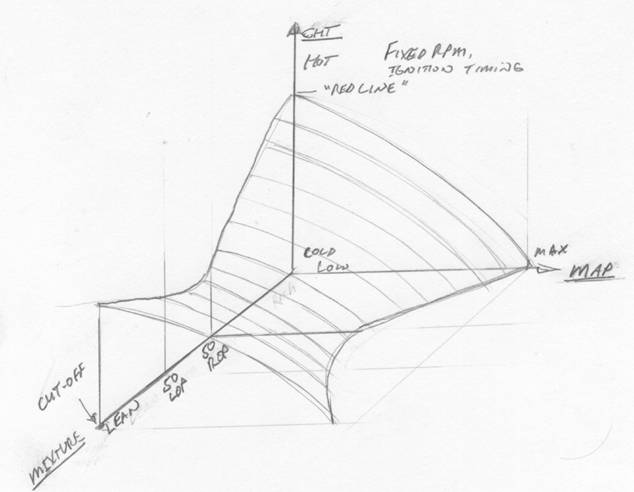This forum is best when it is useful and
helpful. While there have been many helpful
contributions to this thread, the one above is not one of them.
We understand that George has spent a lot
of time, sweat, and money developing data and understanding. Much GAMI work
focused on certified aircraft. GAMI has taught us a lot and helped piston
engine operators save avgas and equipment. It is reasonable that George
wishes to keep proprietary, hard-earned information and know-how private and
confidential. However, within those constraints, George, what can you
tell us without compromising your business? How can you help us?
Certified airplanes have to pass
certification tests. As I recall, this includes things like sustained
full power climb at Vy, gross weight, ISA+20 day, without exceeding red
line. In a turbo engine making lots of power in thin warm air, this means
pouring fuel into the cylinders to prevent detonation. In an aspirated
engine, less fuel is required because manifold pressure and induction
temperature are lower, and power decreases with altitude.
With an experimental airplane with
compromised cooling (most of them), sustained climb at Vy is out of the
question. It is different because it is experimental.
We also know that for certified aircraft,
the red line CHT might be 450-460F, and we experimental pilots like to stay
about 100F cooler than this. If you operate within a different envelope,
then things like acceptable spark plug heat range most likely will be
different. George hits the nail on the head when he suggests it is all
about WHERE in the operating envelope you choose to operate.
I would like to make a suggestion that
might be helpful. I suggest that operators think about the issues of
detonation in terms of a visual 3-D operating envelope in which the three axes
are manifold pressure, mixture, and cylinder head temperature, variables we
control in the cockpit.
We know that if you run hot cylinders and
a lot of manifold pressure, you had better be rich to prevent detonation. We
know that if you run lean of peak, you can run more manifold pressure without
detonation in part because the cylinders will be cooler and in part because of
the way the mixture ignites and burns. And it seems that pressures
get high and trouble seems to focus around the area where mixture is at peak or
slightly on the rich side of peak.
Give all this, have a look at the sketch
below which tries to illustrate the allowable operating envelope. If you
are inside the envelope, you are OK. Outside and you court disaster in
the form of detonation and perhaps other uglies.
I ask George: qualitatively is this about
right? If not, help us understand what the real envelope looks like, or
let us know if this is a faulty concept.

Note that a given envelope is also defined by the octane
rating of the fuel, RPM, ignition timing, and spark plug heat range. Assuming
that this saddle-shaped solid is roughly right, I would suggest that regarding
spark plugs, having the wrong spark plug, or more precisely, having an
excessively hot heat range, shrinks the envelope. Hot plugs
will lead to detonation at richer mixtures or lower manifold pressure or cooler
cylinder head temperatures.
Certified aircraft have to operate within a broadly defined
envelope because the regulators say it must be so.
However, careful operators don’t go out to the corners
of the envelope. They run cooler, or richer (or leaner) or with lower
manifold pressure, and with ignition timing and such within well defined limits
while using the right fuel. Racers push the envelope on MAP and RPM and
perhaps on timing as well.
Those that push MAP, mixture, and temperature outside the
smaller envelope created by hotter plugs or improper timing end up with broken
engines.
So while Randy may see trouble with broken engine parts and
attribute them to the automotive spark plugs, I suggest it may be more accurate
to say that it is likely that a particular engine was operated out of its
safe operating envelope and could not handle it. This envelope may well
be smaller if one uses automotive spark plugs. I don’t know.
And I suggest that Grayhawk and others who have experienced
no difficulty with automotive spark plugs have enjoyed no problems because
their practices keep them well within their operating envelope all the time,
even if they do not know what the limits of the envelope may be. And it
may well be smaller than with aircraft spark plugs.
George, does this sound reasonable? What can you add
or correct?
I think the key message is: if you deviate from standard
certified aircraft practices and hardware, then your operating envelope could
well be smaller. So you best not push into corners of the certified
airplane envelope if you are running higher compression, automotive spark
plugs, more manifold pressure, more RPM, advanced timing, or whatever.
I hope this view point is helpful. More importantly I
hope it is correct. Comments, corrections, and suggestions always
welcome.
Full disclosure: I am keenly interested to learn more,
particularly since I am running an IO-550 with 10:1 pistons, one mag, and one
electronic ignition with automotive spark plugs in the top plug
holes. Why? Because Down Under avgas is US$6.30 a gallon, so
55-60% power LOP is a way of life. I like CHT’s below 320F in the
climb, and frequently see under 300F LOP. That is how I try to stay
inside my envelope. If there is a better way, I would like to learn about
it.
Fred Moreno